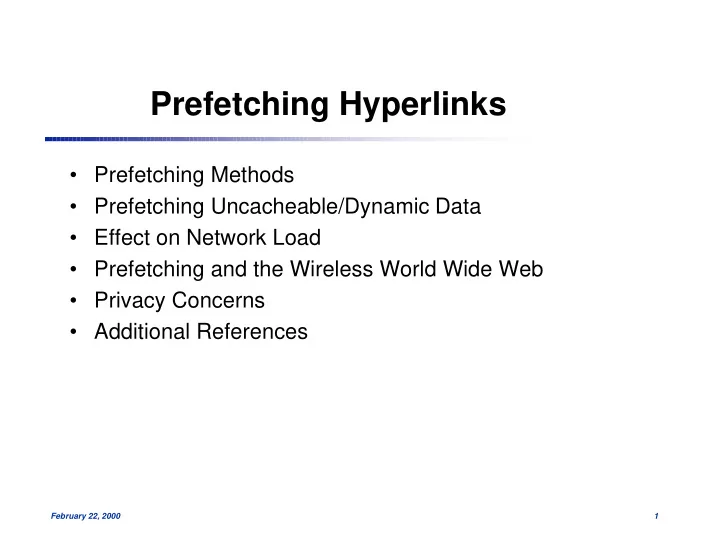

Prefetching Hyperlinks • Prefetching Methods • Prefetching Uncacheable/Dynamic Data • Effect on Network Load • Prefetching and the Wireless World Wide Web • Privacy Concerns • Additional References February 22, 2000 1
Prefetching Methods • History-based - prefetch a link only if you’ve accessed it before. • Link-based - prefetch all embedded hyperlinks and their images. • This implementation is a variant of link-based prefetching. – Prefetch some links, according to usage statistics. – Limit prefetching based on estimated bandwidth usage and probability that the prefetched page will be accessed. February 22, 2000 2
Prefetching Methods • Client side prefetching implementations (local). • Server side prefetching implementations (server-hint). • Previous work concludes that using both client & server statistics resulted in higher hit rates (Section 2.1). – This implementation is a hybrid using both client and server side statistics. • Should a server trust a client to correctly/accurately report usage, referring links, etc? • Should a client trust a server to correctly/accurately report usage, referring links, etc? February 22, 2000 3
Prefetching Uncacheable/Dynamic Data • Prefetching advertisements – Overstated hit rates since the document was fetched, but never accessed. – Section 5.1 indicates 42.6% of prefetched pages were eventually accessed (so 57.4% never accessed, for the math impaired). – Is this an important fact? Do we care? • Prefetching dynamic data – Their implementation specifically ignores zero expiration value. – How to indicate that data expires immediately? Do we need non- prefetchable data (similar to uncacheable data)? – Do people like/dislike this implementation idea? What would you do differently? February 22, 2000 4
Effect on Network Load Prefetching leads to increased network load. • Client specifies a bandwidth limit to prefetching efforts. • Their implementation stopped prefetching when probability of accessing page was < 25%, or bandwidth limit was exceeded. • Overall increase to network traffic was 24% (Section 5.1). – Top 10 Approach [21] reports similar results - 40% of requests were prefetched, with 10-20% increase to network traffic. – Top 10 Approach also implements a trace driven simulation. – Top 10 Approach also suggests prefetching during slow periods (i.e. overnight). February 22, 2000 5
Effect on Network Load Prefetching can lead to bursty network traffic. • Rate controlled prefetching [9, 10] • It wasn’t clear to me if they addressed this issue or not… February 22, 2000 6
Prefetching & Wireless WWW Does prefetching make sense in a wireless environment? + Latencies are longer, so prefetching could (potentially) bring greater benefits. – Bandwidth is constrained, prefetching increases network load, so perhaps prefetching isn’t justified for this application? – Some wireless devices have limited memory • For example, wireless phones (not really true for laptops) • May not be able to store prefetched pages ? The author indicates that 5 KBps (40Kbps) is median bandwidth for prefetching to be effective. (Section 3.3, Figure 3) • Within range of dialup modem... • What about wireless devices? February 22, 2000 7
Prefetching & Wireless WWW February 22, 2000 8
Current Wireless Technologies • Example - WaveLAN – Maximum rate of 11 Mbps – Rate varies from <1 Mbps to 11 Mbps depending on environment (1 Mbps at 50 m in a closed office, etc.) • Example - Qualcomm HDR (High Data Rate) – Maximum rate of 2.4 Mbps on forward link, 307 Kbps on reverse link with 1.25 MHz channel – Average throughput of 600 Kbps on forward link, 220 Kbps on reverse link in a loaded sector February 22, 2000 9
Prefetching & Wireless WWW Does prefetching make sense in this environment? • The bandwidth of current wireless devices is > the median required bandwidth indicated by these experiments. • Reduced client latency by 52.3%. Is this applicable to wireless clients? • We haven’t addressed the issue of available memory on the wireless device. February 22, 2000 10
Prefetching & Wireless WWW Does prefetching make sense in this environment? • Yes - but don’t prefetch to the wireless device/mobile, prefetch to the proxy (WaveLAN access point, base station, etc.)? • Yes - but require more accurate prefetching. Perhaps use a higher threshold below which you will no longer prefetch? (They used 25% in their paper.) • Maybe - because...? • No - because...? February 22, 2000 11
Privacy Concerns • HTML must be available to prefetching mechanism – End-to-end protocols, encryption, tunnels etc. make proxy implementation impossible. • Privacy groups request ability to allow clients not to send the Referer field. This conflicts with prefetching goals. • Usage reports contain sensitive information, more so than Referer field information. • User discomfort with prefetching – Authors claim prefetching collects information that is already available via proxies, firewalls, server access, etc. • Server administrators reluctant to share information on how documents on the server are accessed. February 22, 2000 12
What I Liked... • Thorough discussion of previous work & how it related or differed from their work. • Use of client & server information for predicting what pages to prefetch. • Ability to set bounds on amount of data to be prefetched. • Ideas have actually been implemented (including proxy versions). February 22, 2000 13
What I Didn’t Like... • Extended httpd protocol, but no reference to detailed information is given, you couldn’t go implement this yourself if you wanted to. • I’m not sure all dynamic data can be prefetched (probably most of it can be, but what about the rest?). February 22, 2000 14
Additional References • Product Data Sheet for WaveLAN/IEEE Turbo 11 Mb Network Interface Cards FTP://FTP.WAVELAN.COM/PUB/DOCS/IEEE/brochure/e nglish/fs_pc11.pdf • Qualcomm, Inc. http://www.qualcomm.com/hdr/ • E.P. Markatos and C. E. Chronaki. A Top-10 Approach to Prefetching on the Web. In Proc. INET 98 . July 1998. http://www.ics.forth.gr/proj/arch- vlsi/html_papers/inet98_prefetch/paper.html February 22, 2000 15
Recommend
More recommend